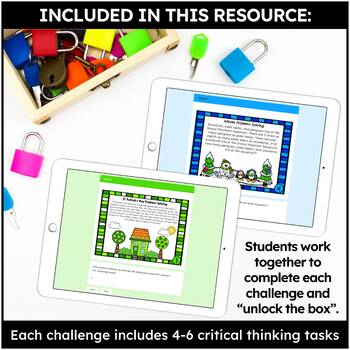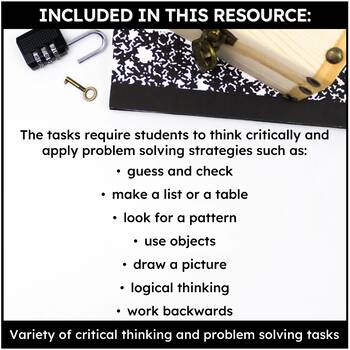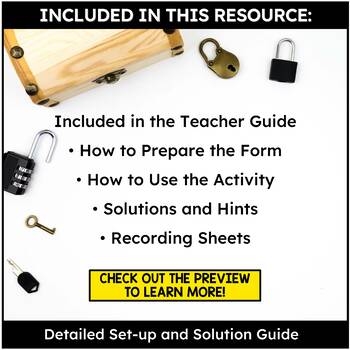Digital Math Escape Room Bundle: Problem Solving & Critical Thinking Activities
- Google Drive™ folder

What educators are saying
Products in this Bundle (6)
showing 1-5 of 6 products
Description
Are you looking for holiday and seasonal math activities to keep your 4th and 5th grade students engaged when maintaining attention is sometimes difficult?
In this seasonal math activities bundle, students use cooperative learning and their math problem solving skills to solve math challenges and "escape the room."
Each fun, engaging, and self-grading resource in this bundle is presented via Google Forms and includes three differentiated levels of challenge with 5-6 problem solving tasks in each challenge. This resource is great for team building and is the perfect way to celebrate the season!
Note: The St. Patrick’s Day Digital Escape Room includes one challenge.
Why buy the bundle?
Each seasonal or holiday-themed digital escape room will be added to this bundle! At this time, there is no specific timeline for completion; however, this bundle will include many of the holidays and celebrations students experience throughout the school year. Each time a new resource is added, the price will increase to reflect the total value of the resources.
How do you get the new activity packs?
After your purchase, be sure you click here to get updates when I add new products. Once I release a new digital escape room pack, I will upload it to TpT as an individual listing and then add the pack to this bundle. All you need to do is go to your "My Purchases" page and download the additional resource.
What’s included in each resource?
✅ 3 digital escape room challenges with 5-6 tasks per set
✅ Directions for set up
✅ Suggested lesson plan
✅ Teaching tips
✅ Hints to help students
✅ Answer key
✅ Recording sheets
What’s unique about this pack?
This bundle is designed to:
❤️ Engage students at a time when attention to task is difficult
❤️ Build critical thinking and math problem solving skills
❤️ Encourage cooperative learning and mathematical communication
❤️ Celebrate holidays and the seasons!
What skills do the challenges cover?
Students use basic math skills and the following problem solving strategies to complete the challenges.
- guess and check
- make a list or a table
- look for a pattern
- use objects
- draw a picture
- logical thinking
- work backwards
What is a digital escape room activity?
A digital escape room activity is a collaborative learning experience for students where teams solve seasonal and holiday problem solving challenges to unlock “digital” locks and earn clues to “escape” the room.
How does a digital escape room work?
A digital escape room activity is like a physical escape room; however, instead of unlocking real lockboxes, students solve problem solving tasks and use a code to unlock “digital” locks. Students then earn a letter they can use to solve a riddle and escape the room after completing all the tasks.
➡️ Check out the preview to learn more about this resource!
Teachers Like You Said . . .
⭐️⭐️⭐️⭐️⭐️ Very engaging for students around the holidays. Students in my class worked in partners and engaged for almost two periods. Illustrations are cute and problems solving is challenging.~ April S.
⭐️⭐️⭐️⭐️⭐️ This worked perfectly to celebrate the holidays with my class. I launched all the three difficulty levels at the same time in Google Classroom. Students worked through each level at their own pace in small breakout rooms. ~ Eileen B.
⭐️⭐️⭐️⭐️⭐️ Great resource for some holiday fun! My students love engaging activities like this one!~ Kellie P.
I hope this product helps your students celebrate the season! -The Routty Math Teacher
----------------------------------------------------------
Keep up with The Routty Math Teacher!
Be the first to learn about doing math The Routty Way. I will send out information about new blog posts, free resources, and new product information. Sound interesting? Become a follower of The Routty Math Teacher by clickinghere</a> or on the green star on any of my product pages and receive email updates in your TPT inbox.
Leave feedback and receive TPT credit!
Did you know that you can build up TPT credit by leaving feedback on our products?
You can submit feedback at the time of purchase or go to “My Purchases” for a list of what you have bought in the past. Next to each title is a “Leave Feedback” button. Click it and leave a rating and comment to receive the credit. Go to TPT Credits to learn how to redeem your credits on future purchases!
Like this pack? Share it with others!
Use the share buttons so others will find it! Just click the Facebook, Twitter, or Pinterest button to share it with others!
Terms of Use: This product is copyrighted by Shametria Routt Banks. All rights reserved. Purchase of this product entitles the purchaser the right to reproduce the pages in limited quantities for classroom use only. Duplication for an entire school, an entire school system, or commercial purpose is strictly forbidden without written consent from the publisher. For questions, please contact Shametria@therouttymathteacher.com





